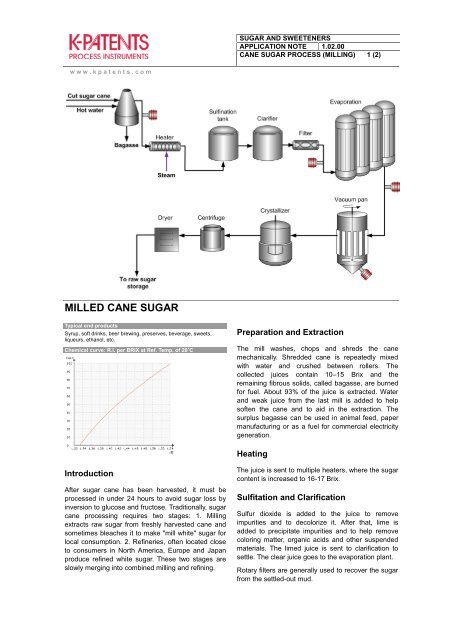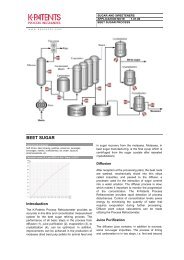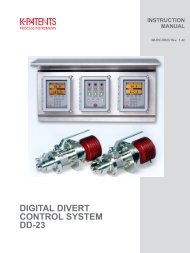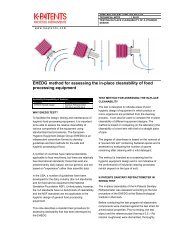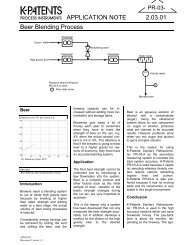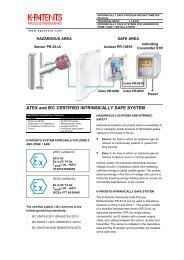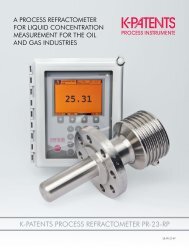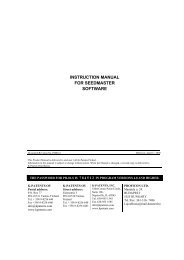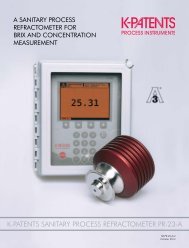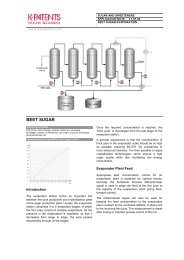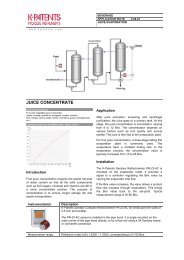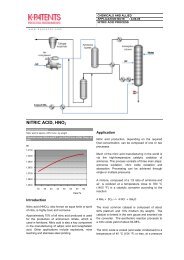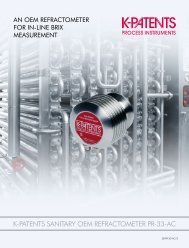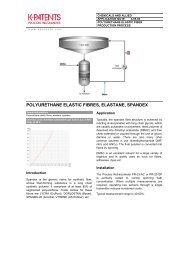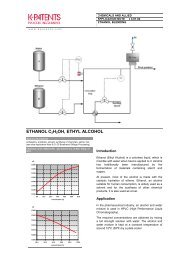1.02.00 Cane Sugar Process - K-Patents
1.02.00 Cane Sugar Process - K-Patents
1.02.00 Cane Sugar Process - K-Patents
Create successful ePaper yourself
Turn your PDF publications into a flip-book with our unique Google optimized e-Paper software.
SUGAR AND SWEETENERS<br />
APPLICATION NOTE <strong>1.02.00</strong><br />
CANE SUGAR PROCESS (MILLING) 1 (2)<br />
w w w . k p a t e n t s . c o m<br />
MILLED CANE SUGAR<br />
Typical end products<br />
Syrup, soft drinks, beer brewing, preserves, beverage, sweets,<br />
liqueurs, ethanol, etc.<br />
Chemical curve: R.I. per BRIX at Ref. Temp. of 20˚C<br />
Preparation and Extraction<br />
The mill washes, chops and shreds the cane<br />
mechanically. Shredded cane is repeatedly mixed<br />
with water and crushed between rollers. The<br />
collected juices contain 10–15 Brix and the<br />
remaining fibrous solids, called bagasse, are burned<br />
for fuel. About 93% of the juice is extracted. Water<br />
and weak juice from the last mill is added to help<br />
soften the cane and to aid in the extraction. The<br />
surplus bagasse can be used in animal feed, paper<br />
manufacturing or as a fuel for commercial electricity<br />
generation.<br />
Heating<br />
Introduction<br />
After sugar cane has been harvested, it must be<br />
processed in under 24 hours to avoid sugar loss by<br />
inversion to glucose and fructose. Traditionally, sugar<br />
cane processing requires two stages: 1. Milling<br />
extracts raw sugar from freshly harvested cane and<br />
sometimes bleaches it to make "mill white" sugar for<br />
local consumption. 2. Refineries, often located close<br />
to consumers in North America, Europe and Japan<br />
produce refined white sugar. These two stages are<br />
slowly merging into combined milling and refining.<br />
The juice is sent to multiple heaters, where the sugar<br />
content is increased to 16-17 Brix.<br />
Sulfitation and Clarification<br />
Sulfur dioxide is added to the juice to remove<br />
impurities and to decolorize it. After that, lime is<br />
added to precipitate impurities and to help remove<br />
coloring matter, organic acids and other suspended<br />
materials. The limed juice is sent to clarification to<br />
settle. The clear juice goes to the evaporation plant.<br />
Rotary filters are generally used to recover the sugar<br />
from the settled-out mud.
SUGAR AND SWEETENERS<br />
APPLICATION NOTE <strong>1.02.00</strong><br />
CANE SUGAR PROCESS (MILLING) 1 (2)<br />
w w w . k p a t e n t s . c o m<br />
Evaporation<br />
The clarified juice is concentrated in a multiple-effect<br />
evaporator to make syrup at about 60 Brix.<br />
Crystallization<br />
The thick juice syrup is further concentrated under<br />
vacuum until it becomes supersaturated and is then<br />
seeded with crystalline sugar. On cooling, more<br />
sugar crystallizes from the syrup.<br />
Centrifuging and Drying<br />
A centrifuge separates the sugar from the molasses.<br />
Additional crystallizations extract more sugar and the<br />
final residue is called blackstrap. After drying the<br />
crystals, the color of the raw sugar varies from yellow<br />
to brown. Bubbling sulfur dioxide, through the cane<br />
juice before evaporation, bleaches most colorforming<br />
impurities into colorless ones. This sulfitation<br />
produces sugar known as "mill white", "plantation<br />
white" and "crystal sugar". Such sugar is the most<br />
commonly consumed in sugar cane -producing<br />
countries.<br />
Benefits<br />
The digital technology of the K-<strong>Patents</strong> <strong>Process</strong><br />
Refractometer, combined with the sturdy design<br />
results in highly accurate and reliable measurements<br />
gives improved control over the complete process.<br />
Instrumentation<br />
Description<br />
K-<strong>Patents</strong> Sanitary Compact Refractometer PR-23-AC for small pipe line sizes of<br />
2.5 inch and smaller.<br />
The PR-23-AC sensor is installed in the pipe bend. It is angle mounted on the<br />
outer corner of the pipe bend directly, or by a flow cell using a 3A Sanitary clamp<br />
or Varivent® connection.<br />
K-<strong>Patents</strong> Sanitary Probe Refractometer PR-23-GP for installations in large<br />
pipes, tanks, cookers, crystallizers and kettles, and for higher temperatures up to<br />
150°C (300 °F). Installation through a 3A Sanitary clamp.<br />
K-<strong>Patents</strong> <strong>Process</strong> Refractometer PR-23-GP is an industrial refractometer for<br />
large pipe sizes and tanks, cookers, crystallizers and kettles. Installation through<br />
a flange or clamp connection.<br />
Measurement range:<br />
Refractive Index (nD) 1.3200 – 1.5300, corresponding to 0-100 Brix
SUGAR AND SWEETENERS<br />
APPLICATION NOTE <strong>1.02.00</strong><br />
CANE SUGAR PROCESS (REFINING) 2 (2)<br />
w w w . k p a t e n t s . c o m<br />
REFINED CANE SUGAR<br />
Typical end products<br />
Syrup, soft drinks, beer brewing, preserves, beverage, sweets,<br />
liqueurs, ethanol, etc.<br />
Chemical curve: R.I. per BRIX at Ref. Temp. of 20˚C<br />
Refining <strong>Process</strong><br />
The first step in refining is called affination, wherein<br />
the raw sugar crystals are treated with heavy syrup<br />
(typically 60-80 Brix) in order to remove the film of<br />
adhering molasses. This strong syrup dissolves little<br />
or none of the sugar but softens or dissolves the<br />
coating impurities. The mixture, called magma, is<br />
spun in centrifuges and washed with hot water to<br />
remove the adhering molasses film.<br />
The washed raw sugar crystals are then dissolved in<br />
water and diluted to about 70 Brix.<br />
Introduction<br />
The raw sugar received by a refinery contains 96,5 to<br />
98,5% sucrose and therefore 1,5 to 3,5% impurities<br />
which comprise organic matter, inorganic<br />
compounds, water and micro-organisms. The raw<br />
sugar is also highly colored.<br />
During carbonation the syrup is mixed with milk of<br />
lime and reacted with carbon dioxide to produce a<br />
precipitate of calcium carbonate (chalk). The chalk<br />
precipitate entraps organic non-sucrose and<br />
inorganic impurities.<br />
Pressure filters are used to remove the chalk<br />
precipitates and to produce clear, light brown syrup.<br />
The brown syrup is then passed over a series of<br />
acrylic and styrene resin columns and granular<br />
activated carbon columns. The resulting low coloured<br />
syrup (fine liquor) is used for crystallisation of white<br />
sugar or for the production of bulk liquid sugar.
SUGAR AND SWEETENERS<br />
APPLICATION NOTE <strong>1.02.00</strong><br />
CANE SUGAR PROCESS (REFINING) 2 (2)<br />
w w w . k p a t e n t s . c o m<br />
The fine liquor, after reduction of its water content by<br />
multiple effect evaporation, is fed to vacuum boiling<br />
pans. Crystallization is initiated by seeding the<br />
concentrated liquor with slurry. The process is<br />
continued until the crystals reach the desired size.<br />
The resultant mixture of crystals and mother liquor is<br />
fed in centrifuges and the sugar crystals are washed<br />
with hot water to remove any adhering syrup.<br />
The K-<strong>Patents</strong>’ <strong>Process</strong> Refractometers are used at<br />
several stages in the refining process. The<br />
measurements taken, are unaffected by entrapped<br />
air bubbles, undissolved components or color<br />
variations in the product. This results in a consistent<br />
product quality.<br />
Reliable monitoring is particularly important for the<br />
control of the pans. It ensures consistency in crystal<br />
size and better yield. Furthermore, the growth of<br />
false grain can be avoided which reduces the need<br />
for product screening.<br />
Instrumentation<br />
Description<br />
K-<strong>Patents</strong> Sanitary Compact Refractometer PR-23-AC for small pipe line sizes of<br />
2.5 inch and smaller.<br />
The PR-23-AC sensor is installed in the pipe bend. It is angle mounted on the<br />
outer corner of the pipe bend directly, or by a flow cell using a 3A Sanitary clamp<br />
or Varivent® connection.<br />
K-<strong>Patents</strong> Sanitary Probe Refractometer PR-23-AP for installations in large pipes,<br />
tanks, cookers, crystallizers and kettles and for higher temperatures up to 150°C<br />
(300 °F). Installation through a 3A Sanitary clamp.<br />
K-<strong>Patents</strong> <strong>Process</strong> Refractometer PR-23-GP is an industrial refractometer for<br />
large pipe sizes and tanks, cookers, crystallizers and kettles. Installation through<br />
a flange or clamp connection.<br />
Measurement range:<br />
Refractive Index (nD) 1.3200 – 1.5300, corresponding to 0-100 Brix.


